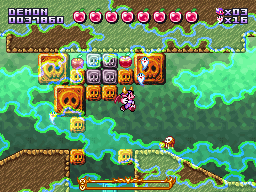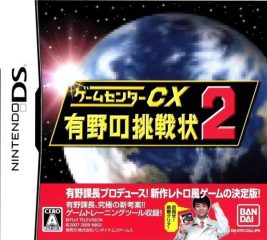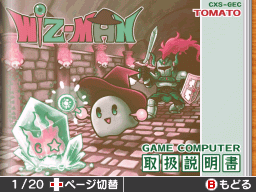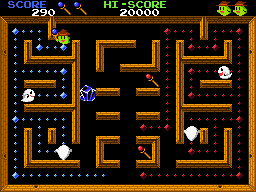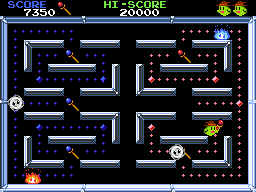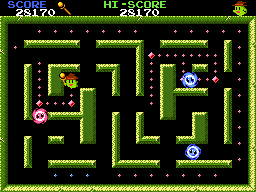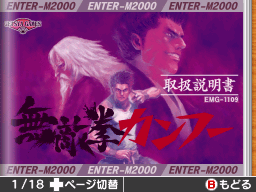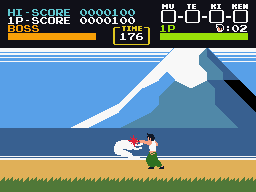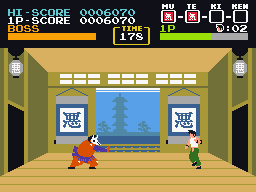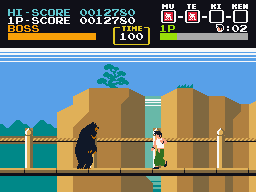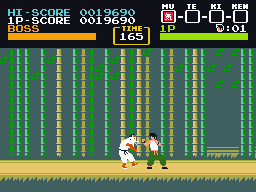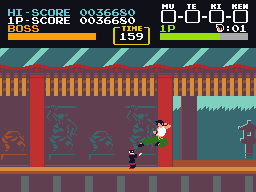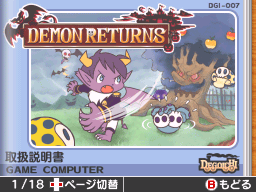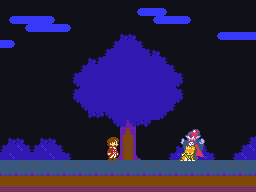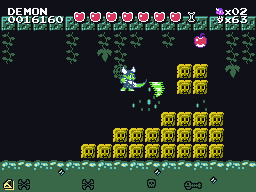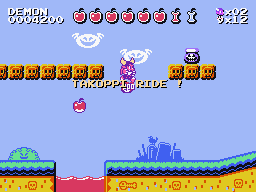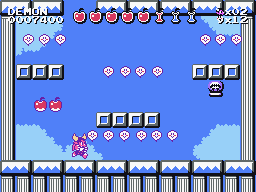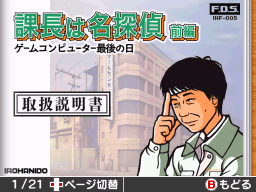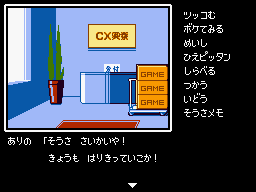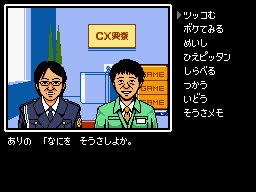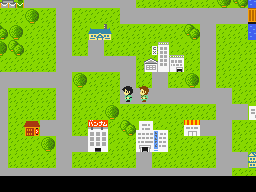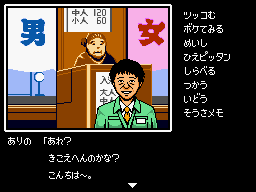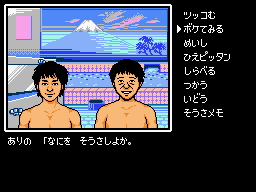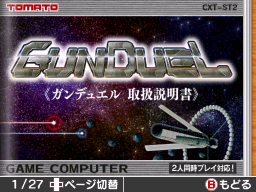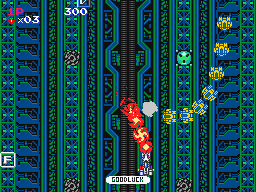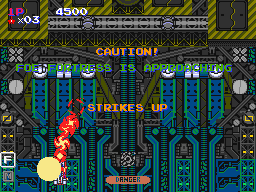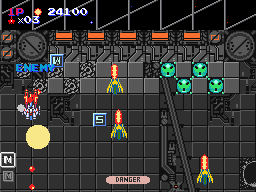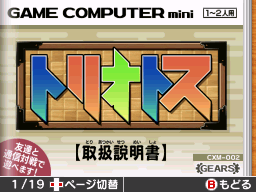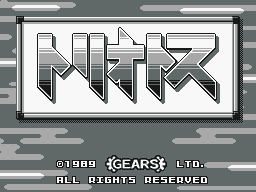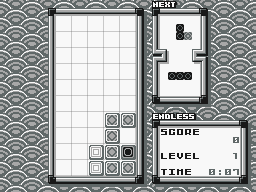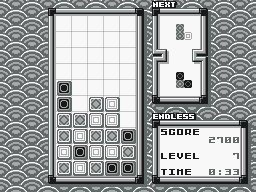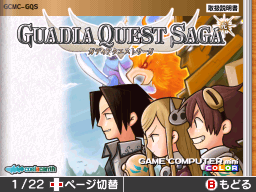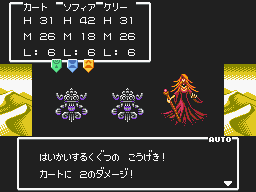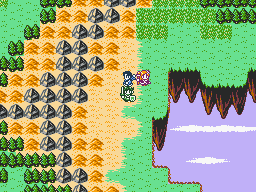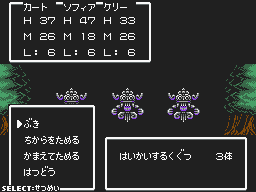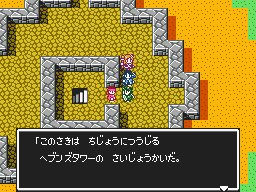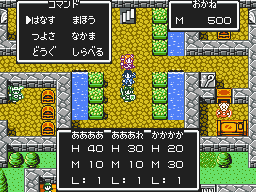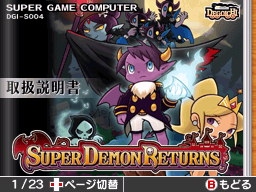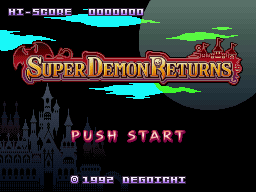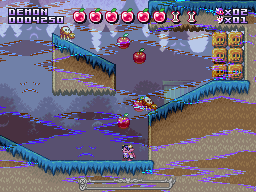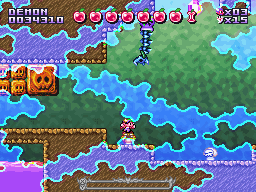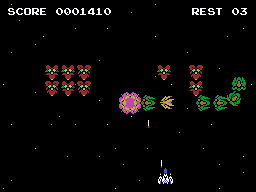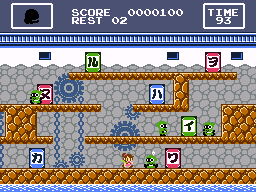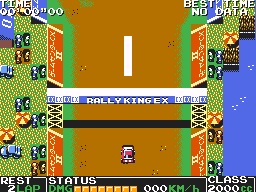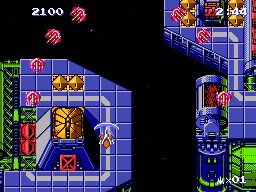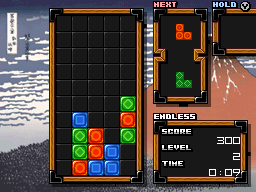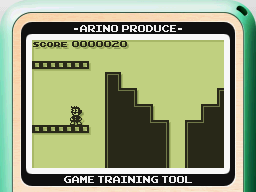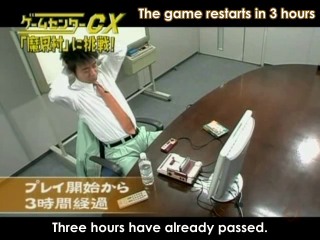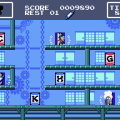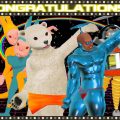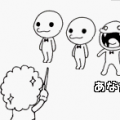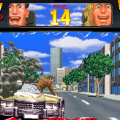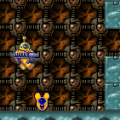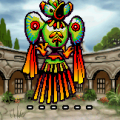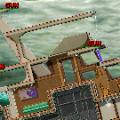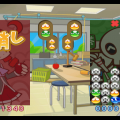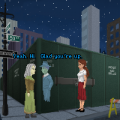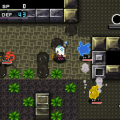- Retro Game Challenge
- Game Center CX: Arino no Chousenjou 2
Game Center CX: Arino no Chousenjou was a surprise hit in Japan, so naturally a sequel was greenlit. The concept is the same, just with several more games – nine in total, along with several variations of games from its predecessor. There are a couple additional features to mix things up a bit. New are daily challenges, which gives you a new challenge in one of the games every day. In addition to sitting around in your living room, you can also visit a game store, which is where you play all of the alternate versions of the games. Finally, you can also phone Arino for advice. If you keep trying and failing challenges, you can keep calling him until he lets you bypass whatever challenge you’re on.
While there’s no single game on here that’s as excellent as Haggleman 3, the quality is more consistent, and there’s no outright stinkers (or even anything on the level of Rally King), making for a more rounded bunch. The only gut punch are the two Detective Kacho games, which are extremely difficult to navigate without knowing Japanese (or at least looking up a walkthrough.) Arino no Chousenjou 2 was not localized since the North American release of the first game didn’t perform well enough, rendering this game all but useless to non-Japanese speakers.
The Games
Being one of the most popular video games ever made, Pac-Man inspired a whole bunch of clones, dubbed “dot eating” games in Japan. Nintendo made their own called Devil World, which is largely forgotten, for charitable reasons. Wiz-man is Game Center CX‘s take on this. The object is obviously to collect all of the dots of the screen while avoiding enemies. Also around each level are colored wands. All of the dots are colored either red or blue, and can only be collected when you’re carrying the wand of the corresponding color. The type of wand will also determine which enemies you can kill, which are also colored. Collecting multiple wands of the same color will make you move faster, and also allow you to attack multiple times. Truth be told, this is kind of a boring game. When you give the character a weapon, it completely removes the intensity that Pac-Man had, and switching between wand colors is more tedious than fun. There are 32 floors in total, though, making for a relatively lengthy game.
Although the name is probably inspired by Konami’s Yie Ar Kung-Fu, Mutekiken Kung Fu is more closely linked to Irem’s Spartan-X (also known as Kung Fu Master outside of Japan.) It also borrows a bit from Broderbund’s Karateka, using similar sprite coloration styles. Much like Karateka (which was released for the Famicom, but strangely, not the NES), Mutekiken Kung Fu is a “yoge” or Western developed game. It’s also for the fictional MES-3000 system, which is meant to be an equivalent to the Sega Mark-III/Master System, although you don’t really get that vibe from playing it.
Mutekiken Kung Fu
Anyway, it’s your standard “walk forward, punch bad guys” theme, with a twist – if you pull off multiple attacks in succession, you’ll send your foe flying across the screen. If they kill another enemy, they’ll release a power orb. Collect four to spell “MU-TE-KI-KEN”, and you’ll enter a super strength mode for a short period of time. These mechanics alone make it much better than similar games of the era. Plus, some of the enemies are particularly cool, like foes ripped straight out of Bruce Lee movies, or the grizzly and panda bears that show up as mid-bosses. There are also snakes, hawks, and floating dragon heads, a nod to the sometimes nonsensical animal foes of 8-bit games. It’s a decent enough title, and it’s certainly far better than any of the games that inspired it.
Demon Returns looks and feels a lot like Super Mario Bros., although there are some very fundamental differences. There are similar power-ups, which cause your demon to grow, and second power-up that allows you to fire wind projectiles. The world is full of destructible bricks, although they need to be directly attacked instead of being hit with your head. There are vases around each stage, which can lead to hidden areas, but can also contain plant-like enemies which breathe fire. Even the level structure is somewhat similar – each world consists of four levels, broken up into outdoors level, an underground level, another outdoors level with a slightly different tile set, and a castle dungeon. There are four worlds in total, making for a total of sixteen stages. That’s half the length of the original Super Mario Bros. – not bad for a “mini” game.
In the most drastic departure from the Mario formula, your demon has a short range claw swipe attack, allowing you to directly attack foes. You can also ride on any disabled enemy, which spins around almost haphazardly. While tough to control, you can use these to double jump onto higher platforms, and can also absorb a single hit from other bad guys. Also at the top of the screen is a “time” meter, similar to Adventure Island, which slowly depletes and can only be refilled by grabbing various bits of fruit.
The intro is practically stolen straight from Ghosts ‘n Goblins, where an evil monster comes in and swipes our hero’s girlfriend, turning you into a demon in the process. The graphic style is almost reminiscent of Monster Party, which must be coincidental considering that game was never released in Japan. This is also one of the better games on this release, but man, is the theme music ever annoying.
This is a series based heavily on Nintendo’s Famicom Detective Club, which were never released outside of Japan. There were several other similar games on the system, too, which used similar interfaces – a picture window on the left side of the screen, menu commands listed on the right, and text displayed on the bottom. The only game that ever saw light in America that used this format is Spellcaster for the SMS (actually Kujaku-Oh), although the Western equivalent to these types of games are probably ICOM/Kemco’s MacVentures games like Shadowgate and Deja Vu.
Anyway, in these types of adventure, you pretty much just go to different areas, meet with people, talk to them, and try to solve vague “puzzles”, usually just by finding the right items or using the right commands. All the way, you’re accompanied by Arino himself. Most of the other characters and locations are based off of episodes of Game Center CX, in addition to areas like Bandai-Namco’s headquarters. In addition to the standard “move”, “look” and “talk” commands, there are also “bokete miru” and “tsukkomu”, which roughly translates to “act like an idiot” or “play it straight”, which are based off the manzai comedy routines Arino is known for. Arino also wears his trademark compress headband when solving problems (they’re usually used to absorb sweat during his challenges.)
Detective Kacho
Like the Famicom Detective Club game series, these are supposed to be disk games, complete with a FDS-style loading intro screen, with mangled English, along with loading screens and simulated disk access sound effects. The only way to get more authentic would be to have the virtual disk belt break, rendering the system unplayable, but that might hit a little to close to home for anyone who had an ever-so-fragile Famicom Disk System. Also like the Detective series, there are two episodes, “Before” and “After”. Only the first needs to be beaten in order to proceed to the next game. Each feature little action mini-games, like bike and boat chase scenes. Unfortunately, since these rely so heavily on not just text, but knowledge of the TV show, it’s all but inpenetrable to non-Japanese games. You can play through it with the help of walkthroughs, but at that point, it’s more of an obstacle than something to be legitimately enjoyed.
Another completely awesome overhead shooter and the third in Tomato’s line of shooters, Gun Duel is essentially the sequel to Star Prince. There are easily a dozen different weapons, each formed by combining two different letters. You can also switch between the dominant letter, essentially giving you two weapons at once. This huge arsenal, along with the mini-boss segments featuring numerous enemy turrets, are very reminiscent of Compile games like Zanac and Power Strike / Aleste. There’s also a two-player mode, where kid Arino will automatically control the second player. The two ships can then combine to form a single, ultra powerful attack vessel. Like Star Prince, it feels too advanced to actually be a FC/NES game, and is more like a TG-16 shooter, but it’s hard to complain when it rocks so hard. There are four stages altogether.
This game is for Game Center‘s equivalent of the Gameboy. It’s a falling block puzzle game that combines Tetris with Sega’s Columns. You drop block formations, each with different gems, and matching three games will cause them to disappear. Instead of cycling through gems like Columns, you rotate the pieces like Tetris. If you manage to fill a line entirely with gems – five across – you create a “spark” which takes down other gems. There’s also a challenge mode where you need to beat an off-screen opponent. As opposed to Tetris‘ Russian visual themes, Triotris is more Japanese themed. The game is also developed by Gears, the same guys who made the (sorely missed) Haggleman games, so occasionally some of the characters will appear. In some ways, this game’s placement almost feels like a paradox. While its visuals are supposed to be nostalgic, Tetris (and other puzzle games) haven’t really aged in the same way that platformers and shooters have. Therefore, it doesn’t really feel all that retro. Plus, like Columns and all of those other rip-offs, it really isn’t nearly as good as Tetris to begin with.</i.tetris<>
This supposed to be for the equivalent of a Gameboy Color, but outside of the boot up screen, it’s nearly impossible to tell, because it looks almost exactly like Guadia Quest from the first game. If they really wanted to go for the same look, they would’ve used the same oversized sprites and poor color palette choices that plagued so many GBC games, especially the Dragon Quest ports.
Guardia Quest Saga
Anyway, this is TECHNICALLY the third game in the Guadia Quest series – apparently Game Center CX just sorta skipped Guadia Quest 2. Still, the game’s fundamentally the same as the first Guadia Quest, with three playable characters, identical commands, and even enemies. It would’ve been cooler if they went the Dragon Quest III route and let you create party members, but no. Instead, its evolution is more like Pokémon – there are two “versions” of game – “Light” and “Dark” – with different monsters. You’re playing one, while Arino is playing the other, allowing you to connect your cartridges to trade. This one should satisfy retro RPG fans once again, and its challenge conditions are much easier than the first game – you don’t even need to visit the first dungeon to conquer it. If you do beat the entire game, there’s a cool twist at the end – the final bosses are the party members from the original Guadia Quest.
This sequel is for the equivalent of the Super Famicom, and its pretty much everything you’d expect – more colorful graphics, copious use of transparencies (which kinda screwed up the emulator, hence the screenshots look a bit off), and some completely gratutious Mode 7, usually manifested as spinning logos. The game itself is more or less the same, although the levels are longer, featuring multi-directional scrolling levels, as opposed to the standard left-to-right levels of the first game.
It’s still just as good as it ever was, but something feels a bit off with this one. For starters, bringing the graphics up to Super Nintendo quality almost puts this on par with other DS games…which almost kind of ruins its vibe, since it no longer seems retro. The music itself doesn’t really sound like the SPC chip either. The other bit is that, other than the color definition and visual effects, the graphics just haven’t been upgraded that much. Looking back at all of the other NES to SNES transitions, there were huge jumps between Castlevania, Super Mario Bros, Contra, even Adventure Island. If this were a true sequel released back in the day, it probably would’ve been lambasted for looking lazy.
Bonus Games
The MASA-X is essentially the MSX, which received a number of FC ports back in the day, especially by Konami. This version reproduces it the look and feel pretty faithfully, especially with the slightly awkward animation and single color sprites, where “black” is simply transparent. There are a few minor differences, including a cameo appearance by Wiz-man. There are only 16 stages in this version, as opposed to 64.
Pretty much the same as the first Haggleman game, except starring his sister Koume. Amusingly, she has her arm in a sling when damaged instead of bugging her eyes like Haggleman. There are a few new enemies too.
The “SA” stands for “Score Attack”. Like the Caravan versions of Hudson’s Star Soldier game, this offers 3-minute and 5-minute modes to score as high as possible. Some of the enemy positions have been changed around too.
This is the Super Game Computer version of Triotris, using much better graphics. There’s a “hold” function, and you can actually see your opponent’s screen in two player mode.
This is basically a trainer for platformer games, where you just run and jump over a variety of obstacles. The graphics are patterned after Game & Watch titles, but the animation is much, much smoother. The title comes from two of Arino’s catchphrases from the show – “Kugure”, meaning “evade”, from an episode with Super Mario World, and “Girijan”, short for “girigiri-jump”, from an episode with the Famicom game Atlantis no Nazo.
Links:
Various Retronauts Links:
Retro Game Challenge Blowout
The Retro Game Challenge Sequel: Wizards and Warriors
The Retro Game Challenge Sequel: Sleuthing and Shooting
The Retro Game Challenge Sequel: Paladins and Platforming
Retro Game Challenge: The Mega Ninja Man
Crunk Games – Game Center CX An episode guide.
TV Nihon Get fansubbed episodes of the show here.
